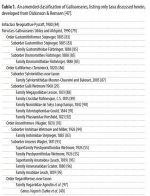Fred Ruhe
Well-known member

Trevor H. Worthy; Federico J. Degrange; Warren D. Handley; Michael S. Y. Lee, 2017
The evolution of giant flightless birds and novel phylogenetic relationships for extinct fowl (Aves, Galloanseres)
Royal Society Open Science. 4 (10): 170975. doi:10.1098/rsos.170975
Abstract:
The extinct dromornithids, gastornithids and phorusrhacids are among the most spectacular birds to have ever lived, with some giants exceeding 500 kg. The affinities and evolution of these and other related extinct birds remain contentious, with previous phylogenetic analyses being affected by widespread convergence and limited taxon sampling. We address these problems using both parsimony and tip-dated Bayesian approaches on an expansive taxon set that includes all key extinct flightless and flighted (e.g. Vegavis and lithornithids) forms, an extensive array of extant fowl (Galloanseres), representative Neoaves and palaeognaths. The Paleogene volant Lithornithidae are recovered as stem palaeognaths in the Bayesian analyses. The Galloanseres comprise four clades inferred to have diverged in the Late Cretaceous on Gondwana. In addition to Anseriformes and Galliformes, we recognize a robust new clade (Gastornithiformes) for the giant flightless Dromornithidae (Australia) and Gastornithidae (Eurasia, North America). This clade exhibits parallels to ratite palaeognaths in that flight presumably was lost and giant size attained multiple times. A fourth clade is represented by the Cretaceous Vegavis (Antarctica), which was strongly excluded from Anseriformes; thus, a crucial molecular calibration point needs to be reconsidered. The presbyornithids Wilaru (Australia) and Presbyornis (Northern Hemisphere) are robustly found to be the sister group to Anatoidea (Anseranatidae+Anatidae), a relatively more basal position than hitherto recognized. South America’s largest bird, Brontornis, is not a galloansere, but a member of Neoaves related to Cariamiformes; therefore, giant Galloanseres remain unknown from this continent. Trait analyses showed that while gigantism and flightlessness evolved repeatedly in groups, diet is constrained by phylogeny: all giant Galloanseres and palaeognaths are herbivores or mainly herbivorous, and giant neoavians are zoophagous or omnivorous.
Free pdf: http://rsos.royalsocietypublishing.org/content/royopensci/4/10/170975.full.pdf
Enjoy,
Fred
The evolution of giant flightless birds and novel phylogenetic relationships for extinct fowl (Aves, Galloanseres)
Royal Society Open Science. 4 (10): 170975. doi:10.1098/rsos.170975
Abstract:
The extinct dromornithids, gastornithids and phorusrhacids are among the most spectacular birds to have ever lived, with some giants exceeding 500 kg. The affinities and evolution of these and other related extinct birds remain contentious, with previous phylogenetic analyses being affected by widespread convergence and limited taxon sampling. We address these problems using both parsimony and tip-dated Bayesian approaches on an expansive taxon set that includes all key extinct flightless and flighted (e.g. Vegavis and lithornithids) forms, an extensive array of extant fowl (Galloanseres), representative Neoaves and palaeognaths. The Paleogene volant Lithornithidae are recovered as stem palaeognaths in the Bayesian analyses. The Galloanseres comprise four clades inferred to have diverged in the Late Cretaceous on Gondwana. In addition to Anseriformes and Galliformes, we recognize a robust new clade (Gastornithiformes) for the giant flightless Dromornithidae (Australia) and Gastornithidae (Eurasia, North America). This clade exhibits parallels to ratite palaeognaths in that flight presumably was lost and giant size attained multiple times. A fourth clade is represented by the Cretaceous Vegavis (Antarctica), which was strongly excluded from Anseriformes; thus, a crucial molecular calibration point needs to be reconsidered. The presbyornithids Wilaru (Australia) and Presbyornis (Northern Hemisphere) are robustly found to be the sister group to Anatoidea (Anseranatidae+Anatidae), a relatively more basal position than hitherto recognized. South America’s largest bird, Brontornis, is not a galloansere, but a member of Neoaves related to Cariamiformes; therefore, giant Galloanseres remain unknown from this continent. Trait analyses showed that while gigantism and flightlessness evolved repeatedly in groups, diet is constrained by phylogeny: all giant Galloanseres and palaeognaths are herbivores or mainly herbivorous, and giant neoavians are zoophagous or omnivorous.
Free pdf: http://rsos.royalsocietypublishing.org/content/royopensci/4/10/170975.full.pdf
Enjoy,
Fred





